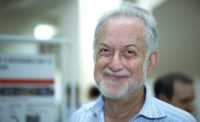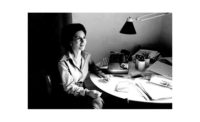Friends and Colleagues Remember Leslie E. Robertson

The Twin Towers of the World Trade Center were engineered by Leslie Robertson.
Photo © Yann Forget / Wikimedia Commons
Beloved structural engineer Leslie E. Robertson died on February 11, 2021, one day before his 93rd birthday, of cancer. Robertson, a renowned innovator for supertall structures, was the lead structural engineer of the original World Trade Center in New York City.
Read ENR's obituary for Robertson and find tributes from his friends and colleagues below.
Editor's note: This story was last updated on 2/12/21 at 3:39 p.m.
Guy Nordenson, Guy Nordenson & Associates
Years back, shortly after 9-11, I was asked about Les and described him as the Steve Jobs of structural engineering. He had a painterly feeling for structure, particularly steel. The drawing (click here to view the PDF) we did at Princeton University illustrates the varied steels used in the World Trade Center towers and displays the extraordinary and sublimated genius of Les’s design of that structure. His solution saved many lives by delaying the inevitable collapse of the towers on that horrible day. Like Jobs, Leslie Robertson was a force field of ingenuity, invention, and inspiration. I am deeply grateful to have been his friend for 35 years. He was a national treasure.
Jayne Merkel, architectural historian and critic
Leslie Robertson wasn’t simply an extraordinary engineer. He was an extraordinary human being. I once ran into him after I was released from jury duty because enough potential jurors were found before my name was called. I was relieved.
When I told Les, he said, “I can’t serve on jury duty. I’ve been arrested too many times.” Then he added— “For protesting.” Les and his wife Saw Teen not only participated in numerous protests in Washington for good causes, they rented vans to take other people as well. And because they deeply believed in democracy, they didn’t only offer seats to people on their side of the political spectrum. Sometimes they included those going to demonstrate for the opposite side.
Whenever Les would regret the loss of life in the World Trade Center bombing, I would remind him (though of course he knew) that almost everyone who worked below the areas where the planes crashed into the towers actually survived, because the towers stood long enough for them to get out on stairways. And when the towers fell, they crumbled in place, instead of toppling over to destroy more lives and buildings. Even historic St. Paul’s Chapel, right across the street, survived.
Carol Willis, founding director, The Skyscraper Museum
The grace and elegance of the structures designed by Leslie E. Robertson were matched by the depth of Les’s humanity. He was the brilliant and innovative structural engineer of skyscraper giants of the mid-20th century, including the original World Trade Center and the U.S. Steel Tower in Pittsburgh, and in this century, of global supertalls such as Shanghai World Financial Center and Lotte World Tower in Seoul. His designs were a combination of keen insight and intuitive analysis, but he always emphasized his love of collaboration with architects he admired and counted as lifelong friends, most especially Minoru Yamasaki and I. M. Pei. With Pei he created the Bank of China in Hong Kong, a peerless skyscraper. His wife of nearly 40 years, structural engineer SawTeen See, was his closest partner in practice and in life.
James von Klemperer, president and design director, KPF
We were all so fortunate to know Les, and to appreciate his penetrating insights into the worlds of architecture, physics, social justice, and more. Those of us who worked with him witnessed his fiercely independent spirit, and the originality of his keen intelligence. He had a way of discussing controversial topics with absolute candor, sometimes raising the eyebrows of his clients and collaborators, but with a characteristic charm that carried the day.
Eric Höweler, co-founder and partner, Höweler + Yoon Architecture
I remember Les Robertson coming up to Boston on the Amtrak, backpack over his shoulders, to give guest lectures to my students at the GSD. Les would show projects, tell stories, and impart wisdom. Always with a twinkle in his eye and a smile on his face. One time, we went over the schedule and another professor came looking for his class- which had all failed to show up to the next class because they were transfixed by Les. His openness to discuss the World Trade Center was also memorable. Les would talk about his role on the design of the structure, how he used punch cards to calculate the steel members, how proud he was of the innovations, and how heartbroken he was by the events of 9/11. His presentation was full of insights and wisdom- and humanity. He'll be remembered for his generosity, his sense of humor, and his kindness.



